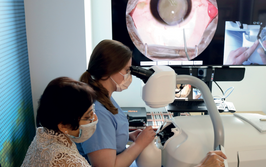
DED 101
Tackling the pathophysiology of dry eye disease with targeted treatment
Giulio Ferrari, Matteo Pederzolli, Andrzej Grzybowski | | 4 min read | Discussion

Dry eye disease (DED) affects a significant portion of the population worldwide, with prevalence estimates varying greatly among different regions, demographics and occupational profiles, from less than 5 percent but up to 50 percent. It is almost twice as common in women than in men, and subjects older than 50 years old are at increased risk of developing DED.
The development and severity of DED are affected by external factors and systemic conditions, such as
- environmental factors (including exposure to dry air, windy weather or air fluxes, tobacco smoke, chemical irritants)
- lifestyle habits (such as prolonged screen time)
- systemic diseases (Sjögren syndrome and many other autoimmune conditions, thyroid disease, Parkinson’s disease, diabetes, graft-versus-host disease, dermatological disorders, vitamin A deficiency)
- oral medications (including antihypertensive and diuretic drugs, hormonal treatments, benzodiazepines and antidepressants, steroidal and non-steroidal anti-inflammatory medications, anticancer agents, and isotretinoin).
Local factors associated with DED include
- use of contact lenses
- previous or current ocular diseases (such as blepharitis), allergies, previous conjunctival burns, or herpes keratitis
- topical drugs use (as seen often in glaucoma patients), either due to active ingredients or preservatives
- previous ocular surgery, especially involving the anterior segment or the annexa.
Figure 1. Risk factors for dry eye disease.
DED diagnosis
The pathophysiology of DED has been traditionally associated with reduced quantity and/or quality of the tear film and ocular surface inflammation. Tears play a vital role in maintaining eye health by lubricating the surface of the eye, washing away foreign particles, and providing a smooth optical surface for clear vision. When the tear film is disrupted, either due to reduced tear production, excessive tear evaporation, or an imbalance in its composition, individuals experience symptoms associated with DED.
Thorough examination of general and ocular history is necessary to identify systemic and local predisposing conditions. Questionnaires allow physicians to quantify the severity of symptoms and the impact of the disorder on quality of life, as well as to monitor disease progression and treatment response. Multiple questionnaires are routinely used in DED symptoms evaluation, including the Ocular Surface Disease Index (OSDI), the Dry Eye Questionnaire (DEQ-5), and the Standardized Patient Evaluation of Eye Dryness (SPEED).
Eyelid anatomy and function should be assessed during patient encounters. During slit lamp examination, signs of anterior blepharitis and meibomian gland dysfunction must be investigated. Ocular surface status is then evaluated through fluorescein and lissamine green staining.
Quantity, stability, and composition of the tear film are usually assessed through tear meniscus measurement and invasive or non-invasive tear film break-up time. Tear composition, osmolarity, and metalloproteinase-9 concentration can also be measured.
In those cases where a systemic disease is considered to complicate or be the cause of DED, further testing may be required.
Tried and tested
Proper diagnosis and management strategies, ranging from lifestyle modifications to medical interventions, are essential in alleviating symptoms and preventing potential complications associated with DED. Recent years have seen new medications and devices reach the clinical arena.
The two pillars of DED treatment: a targeted approach and a step-by-step progression.
Specific factors (tear deficit, altered tear film composition, predisposing systemic conditions) should be addressed in a personalized treatment plan.
As suggested by the Tear Film and Ocular Surface Society International Dry Eye Workshop II (TFOS DEWS II), the first step usually requires patient education, lifestyle and environmental adjustments, warm compresses and lid hygiene, and the use of tear film substitutes (preferably preservative-free). When these measures are not sufficient to control DED, topical steroids, Cyclosporine, Lifitegrast, secretagogues, topical or systemic antibiotics, or in-office treatments (for example, punctal plugs, intense pulse light) should be considered.
Severe cases may require the administration of systemic secretagogues, bandage contact lenses, or autologous serum drops. Finally, amniotic membrane, tarsorrhaphy, and other surgical interventions may be indicated in refractory patients.
Though the mechanism(s) of action of many of these treatments is often not completely understood, the final aim is clear: to improve lubrication and reduce inflammation of the ocular surface. Their efficacy varies depending on disease stage – and it is not uncommon for DED patients to try multiple treatments before the disease is controlled.
Despite extensive efforts from physicians and pharma companies, however, a substantial number of patient complaints of ocular surface discomfort and pain – even when lubrication and inflammation appear clinically well controlled.
Figure 2 : A step-wise approach to the treatment of dry eye disease.
A new target?
In our view, the pathophysiology of DED needs further elucidation. In this vein, the role of neurosensory alterations is increasingly acknowledged as a fundamental component of DED. These include morphological and functional abnormalities of sensory nerves reaching the cornea. Though the exact nature and impact of specific neuropathological alterations is still the object of study, ocular surface discomfort and pain are certainly a common finding in these patients. In the coming years, it seems likely that new therapeutic modalities will be developed to address this aspect, which substantially impairs the quality of life of DED patients.
Giulio Ferrari, MD, PhD, Group Leader, Eye Repair Lab Unit, IRCCS San Raffaele Hospital and Associate Professor, Vita Salute San Raffaele University, Italy.
Matteo Pederzolli, MD, Department of Ophthalmology, IRCCS San Raffaele Hospital.
Andrzej Grzybowski is a professor of ophthalmology at the University of Warmia and Mazury, Olsztyn, Poland, and the Head of Institute for Research in Ophthalmology at the Foundation for Ophthalmology Development, Poznan, Poland. He is EVER President, Treasurer of the European Academy of Ophthalmology, and a member of the Academia Europea. He is a member of the International AI in Ophthalmology Society (https://iaisoc.com/) and has written a book on the subject that can be found here: link.springer.com/book/10.1007/978-3-030-78601-4.













